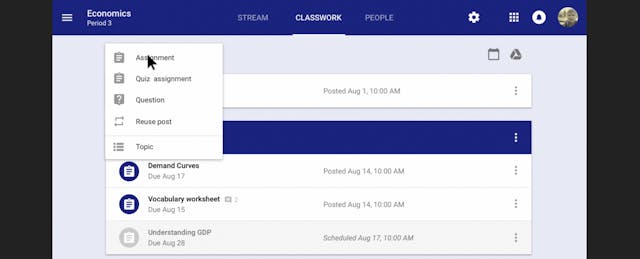When Google’s education users return to schools this fall, their classrooms may look different in more ways than one.
Google Classroom, the company’s online tool that lets teachers, students and parents manage assignments and discussions, will be getting a small facelift as part of 12 updates that Google is announcing at this week’s ISTE conference, an annual K-12 educational technology expo.
First launched in 2014, Google Classroom is now used by more than 30 million students and teachers around the world, the company claims. For schools that rely on Google’s productivity tools (bundled as G Suite for Education), Classroom has become an indispensable way for teachers and students to manage their work.
Over the years, Classroom has morphed in its looks and features—and it will do so again. Currently, when teachers and students log into their Classroom page, they see a stream of assignments and notifications in reverse-chronological order. (In other words, the most recent activity sits at the top.) But users reported difficulty locating older posts, as they had to scroll down to find them. “As people use the stream more and more, it can get really crowded,” says Zach Yeskel, a product manager at Google, in an interview.
Soon, users will see a new tab labeled “Classwork” that will take them to a page where assignments and quizzes can be organized by topics. That means a math teacher can group all activities related to fractions, or an English teacher can post recurring assignments in just one place (instead of having to post to the stream every time).
Educators using Google Classroom will also see a new “People” tab, where they can manage and edit user accounts and privileges for co-teachers, students and their guardians.
These updates, says Yeskel, are built to “save teachers time and improve communications with students across the classroom.” Specific to Classwork, he adds that the new features are designed to “consolidate information to help teachers and students get what they need quickly.”
Other Classroom-related announcements, outlined in this blog post, include the ability for teachers to create and distribute a Google Forms quiz directly from Classroom. (Before, they had to create it outside of Classroom, and copy and paste the URL over.) And in schools that use Google’s administration console to manage Chromebooks, teachers can also lock students’ screens when they are taking a quiz, to prevent them from accessing other tabs on their devices.
“Chromebooks are very much used for testing,” Yeskel notes, “and what I think is powerful is that this [new feature] puts the teachers in control.”
Chromebooks also continue to be the computer of choice in K-12 education. Last year, these devices made up roughly 60 percent of all devices shipped in the U.S, K-12 market, according to Futuresource, a U.K.-based market research firm.
Its competitors are not sitting idly, however. Earlier this year in March, Apple unveiled a new iPad, along with educational software including Schoolwork, which offers similar capabilities as Google Classroom. Microsoft has been rumored to launch a new Surface tablet for the education market later this summer.
Outside of Classroom, Google’s updates include a new Acer Chrome OS tablet, along with a new stylus from Staedtler, the German-based writing instrument company. Google is even aiming to compete in the interactive whiteboard space as it plans to offer educational pricing for its Jamboard.
Google also says it is expanding curriculum for K-12 professional development (through its new Teacher Center), its computer science programs and Be Internet Awesome, a game that aims to impart digital literacy skills.
Updates to Google Classroom, including Classwork, will be available to all users this fall. Teachers can also sign up for beta access to test-drive the new tools before their public release.
These flurry of updates suggest that Google is not resting on its laurels in the K-12 education market. It may have captured pole position in the U.S., but that’s not the case abroad. Outside the U.S., Microsoft accounted for 44 percent of mobile education devices shipped in the first quarter of 2018—more than its competitors. And it recently acquired Flipgrid, a video-discussion social learning platform, to bolster its education offerings.


